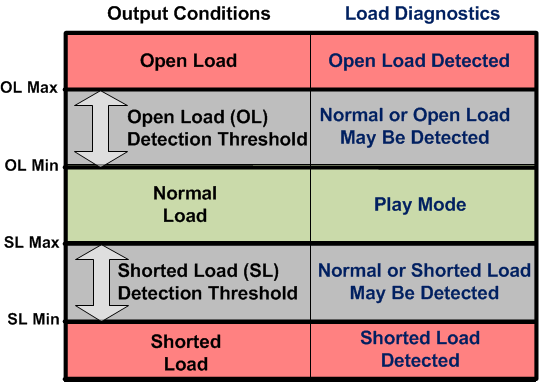ZHCSEH3B December 2015 – September 2018 TAS5411-Q1
PRODUCTION DATA.
- 1 特性
- 2 应用
- 3 说明
- 4 修订历史记录
- 5 Device Comparison Table
- 6 Pin Configuration and Functions
- 7 Specifications
- 8 Parameter Measurement Information
-
9 Detailed Description
- 9.1 Overview
- 9.2 Functional Block Diagram
- 9.3 Feature Description
- 9.4 Device Functional Modes
- 9.5 Register Maps
- 10Application and Implementation
- 11Power Supply Recommendations
- 12Layout
- 13器件和文档支持
- 14机械、封装和可订购信息
9.3.5.1 Load Diagnostics Sequence
The load diagnostic function runs on deassertion of STANDBY or when the device is in a fault state (dc detect, overcurrent, overvoltage, undervoltage, or overtemperature). During this test, the outputs are in a Hi-Z state. The device determines whether the output is a short to GND, short to PVDD, open load, or shorted load. The load diagnostic biases the output, which therefore requires limiting the capacitance value for proper functioning; see the Recommended Operating Conditions. The load diagnostic test takes approximately 229 ms to run. Note that the check phase repeats up to 5 times if a fault is present or a large capacitor to GND is present on the output. On detection of an open load, the output still operates. On detection of any other fault condition, the output goes into a Hi-Z state, and the device checks the load continuously until removal of the fault condition. After detection of a normal output condition, the audio output starts. The load diagnostics run after every other overvoltage (OV) event. The load diagnostic for open load only has I2C reporting. All other faults have I2C and FAULT pin assertion.
The device performs load diagnostic tests as shown in Figure 11.
Figure 12 illustrates how the diagnostics determine the load based on output conditions.
 Figure 11. Load Diagnostics Sequence of Events
Figure 11. Load Diagnostics Sequence of Events  Figure 12. Load Diagnostic Reporting Thresholds
Figure 12. Load Diagnostic Reporting Thresholds